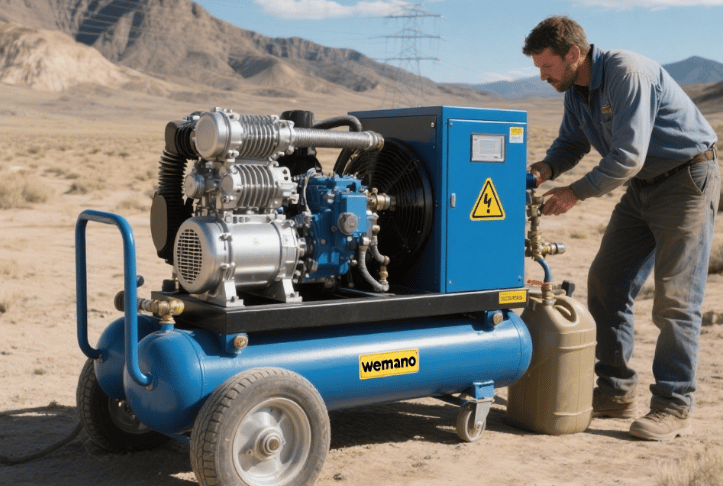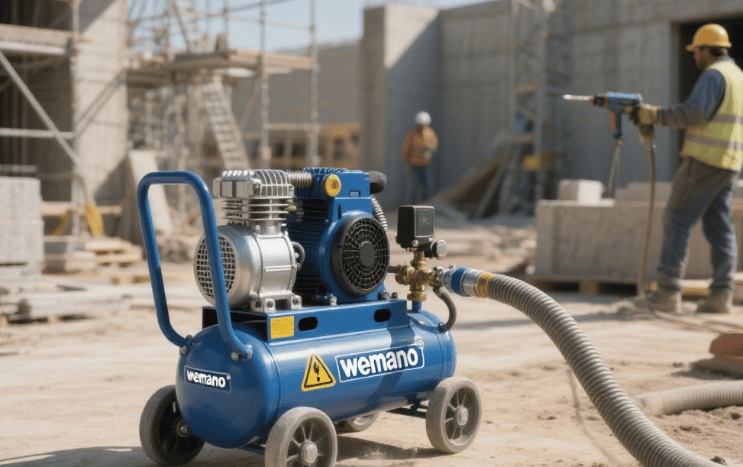Portable Rotary Screw Air Compressors: Selection, Maintenance, and Performance Tips
Portable rotary screw air compressors combine mobility with industrial performance. These compressors use rotating screws to deliver continuous airflow, making them “ideal for continuous operation and higher air demands”. They run smoothly and often more quietly than piston models, suiting heavy-duty workshop and construction use. Asia-Pacific is a leading market (over 42% share of portable compressors in 2024), reflecting strong demand in factories and job sites. This guide outlines how to choose the right compressor size, maintenance schedules, cleaning methods, and cost factors—integrating Wemano’s rotary screw compressors and parts service.
Sofiya
7/26/20254 min read
1.Choosing the Right Compressor Size and Features
Selecting the proper compressor starts with matching its specifications to your needs. Key factors include:
Horsepower (HP): Higher HP means greater power and airflow, letting the unit handle more demanding tools.
(1)Tank Size (Capacity): A larger air tank provides longer run time before the motor cycles on, which is useful for intermittent high-demand tools.
(2)Airflow (CFM/m³/min): The compressor’s free air delivery. Ensure the rated CFM meets or exceeds the requirements of your pneumatic tools.
(3)Pressure (PSI/bar): The maximum pressure the compressor can generate. Choose a unit whose max PSI is above your tools’ needs.
(4)Duty Cycle & Portability: A high-duty-cycle unit can run continuously for long periods. For mobile use, look for a portable design with wheels and handles.
(5)Noise Level: Oil-lubricated rotary screws tend to operate with less noise. Some models include sound-enclosure features to reduce decibel levels.
(6)Power Source: Diesel-powered models run independently of grid power and are great for remote sites, while electric compressors are cleaner and often quieter.
By evaluating these specs, workshop owners can pick a compressor that fits their production demands. Wemano offers both diesel and electric portable screw air compressors, so buyers can choose based on site needs (e.g. diesel for outdoor use, electric for indoor applications).


Maintenance and Cleaning Schedule
Routine maintenance is crucial to keep compressors efficient and avoid downtime. A well-maintained compressor will also last longer and reduce repair costs. Key tasks include:
Daily Checks: Each day check oil and coolant levels in the compressor and engine, and add fluids if needed. Drain any water from the fuel/water separator or air receiver to prevent rust. Verify that gauges read correctly and safety valves are working.
(1)Air Filter: Inspect and clean the intake air filter daily. A clogged filter increases pressure drop and forces the motor to work harder. Replace the filter element when it becomes dirty to maintain airflow and efficiency.
(2)Cooling System: Clean the compressor coolers and engine radiators regularly. Clogged coolers can cause overheating and shutdowns. In dirty environments (e.g. outdoor or dusty job sites), increase cleaning frequency.
(3)Oil and Lubrication: Follow the manufacturer’s oil change schedule. Compressor oil should be changed after the recommended run hours; fresh oil reduces internal friction and heat buildup. Check the oil level daily using the sight glass or dipstick.
(4)Filters and Wear Parts: Replace oil filters, separators, and drive belts at the specified intervals. Filters and engine belts are common wear items. Keep a stock of genuine Wemano replacement parts (filters, hoses, belts) on hand to minimize downtime.
(5)Break-in Inspection: Perform a thorough check (around 50 operating hours) to clear any manufacturing debris and verify system integrity.
Following a structured maintenance schedule as above will ensure reliable operation. For example, industry guides recommend daily fluid checks and using 250-500hour service kits to simplify maintenance.


Cleaning Methods and Parts Replacement
Keeping the compressor and its parts clean prevents performance losses and extends service life. Key cleaning and replacement steps:
Intake Filter Cleaning: Remove the air intake filter and blow or wash out dirt, or replace the element if it’s fouled. A clean filter prevents pressure loss in the intake.
(1)Aftercooler/Intercooler: If equipped, flush condensate from aftercoolers regularly. Clear any dust or debris from cooling fins to maintain heat exchange efficiency.
(2)External Surfaces: Wipe down the compressor housing and engine to remove dust buildup. Accumulated dust can insulate heat and restrict airflow.
(3)Replacement Parts: Use OEM-quality parts for best results. Wemano’s parts replacement service supplies genuine compressors filters (air/oil), separators, and belts matched to each model. Using correct parts ensures optimal fit and avoids leaks or failures.
Regular cleaning, combined with timely replacement of wear parts, keeps the compressor operating at peak efficiency.
Performance and Efficiency Tips:
To maximize performance:
Match Output to Demand: Operate the compressor near its design point. Oversizing pressure wastes fuel, while undersizing leads to continuous running.
(1)Minimize Air Leaks: Inspect hoses, fittings, and connections for leaks. Even small leaks can significantly reduce effective CFM and increase run time.
(2)Optimize Pressure Settings: Run the compressor at the lowest pressure that meets tool requirements. Excess pressure increases power consumption.
(3)Avoid Idling: Don’t leave the compressor running unloaded for long periods. Use the compressor’s auto-idle or simply shut it off if not in use.
(4)Ambient Conditions: Ensure the compressor is not exposed to extreme temperatures. High heat or humidity (common in some Asian climates) can reduce efficiency; provide proper ventilation.
(5)Energy-Saving Features: Take advantage of advanced features if available – e.g., Wemano offers optional variable-frequency drives or permanent-magnet motors for better efficiency at partial loads.
(6)Regular Inspection: Listen for abnormal noises or vibration that could indicate a problem (e.g. belt slippage or misalignment). Address issues promptly.
Well-maintained compressors running at optimal conditions (clean filters, correct oil, no leaks) will deliver their rated airflow while using less energy.
Pricing and Budget Considerations:
Budgeting for a compressor involves balancing upfront cost against long-term value:
(1)Initial Cost vs. Lifecycle: Portable screw compressors vary widely in price. Higher-end models (like Wemano’s) often cost more initially but can save money through greater durability and fuel efficiency. As one industry guide notes, “air compressors range significantly in price; set a budget before starting”.
(2)Operating Costs: Factor in fuel or electricity consumption, maintenance, and downtime. An efficient compressor might cost more up front but reduce operating expenses.
(3)Total Investment: Consider the compressor as an investment. For example, a more efficient model may pay for itself via energy savings over time. It’s wise to match the budget to your expected usage intensity.
(4)Rental/Lease Options: Small shops may explore renting a portable compressor or leasing it to manage cash flow. Compare rental rates versus purchase over the expected usage period.
Wemano offers competitive pricing and flexible financing to help small businesses access reliable compressors without excessive upfront cost.
Why Choose Wemano:
Wemano’s lineup of portable rotary screw compressors is designed for industrial and workshop users:
(1)Reliability: Robust screw air ends engineered for continuous-duty cycles.
(2)Low Maintenance Design: Accessible service panels and quality components simplify routine maintenance tasks.
(3)Parts & Service: Wemano provides genuine replacement parts (filters, oil separators, etc.) and convenient service kits tailored to each model, ensuring proper upkeep.
(4)Technical Support: Expertise in compressor sizing, setup, and after-sales support helps users get the best performance.
Integrating Wemano’s products and services means buyers not only get a well-built compressor, but also the support network (spare parts and technical advice) needed to keep it running optimally.
